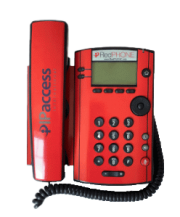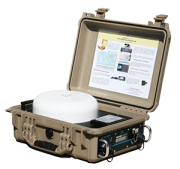
Providing Communications To Responders Who Protect And Save Lives
DISASTER PREPAREDNESS 101 FOR BUSINESSES
Learn how to build a foolproof disaster preparedness plan that will help keep your business afloat in an emergency scenario.
Table of Contents
- Introduction: Why Is a Business Disaster Preparedness Plan Important?
- Program Management: Who Will Oversee Your Plan?
- Emergency Planning: What Risks Do You Face?
- Implementation: What Should You Include in Your Disaster Preparedness Plan?
- Testing & Improvement: What Metrics Will Determine Success?
- What Tools Do You Need? Emergency Communication Technologies
Introduction: Why Do You Need a Business Disaster Preparedness Plan?
Emergencies often occur with little to no warning. A disaster preparedness plan for your business can be crucial for saving lives and critical infrastructure. In addition, having an actionable plan ensures that no matter what happens, your company can sustain essential business operations for days or even weeks.
According to FEMA, 20% of companies have no disaster recovery plan in place, and about 25% of businesses do not reopen after disasters. Don’t let yours be one of them!
Today, we’ll walk you through four essential disaster preparedness steps, enabling you to build an emergency response plan that works for your organization.
Program Management: Who Will Oversee Your Plan?
Emergency Planning: What Risks Do You Face?
Disaster preparedness planning takes “what if” scenarios into account and plans for contingencies that keep crucial business functions up and running no matter the circumstances. A vital component of this process is risk assessment.
- What hazards or risks does your business face? For example, you should gather information about the likelihood of certain natural disasters and their potential impact based on your geographical location.
- Which risks are the most critical? Conducting a business impact analysis (BIA) helps identify essential processes and the impacts of disrupting those processes. A BIA also helps determine what resources may be required to support these business processes.
Implementation: What Should You Include in Your Disaster Preparedness Plan?
According to Ready, a national public service campaign designed to educate and empower people to prepare for and mitigate emergencies, the following factors should be considered when implementing your disaster preparedness plan:
- Resource Management: What resources do you need to respond to emergencies, communicate during and after an incident, and continue business operations?
- Emergency Response: What plans must you develop to protect people, property and sensitive data? Consider including evacuation, sheltering in place, lockdown, and guarding against threats identified during your risk assessment.
- Crisis Communications: How should you communicate vital information to employees, customers, stakeholders, and media?
- Business Continuity: How will you overcome any business disruption?
- Information Technology: How will you recover computer hardware, connectivity and electronic data to support critical business processes?
- Employee Support & Assistance: How will your business encourage your employees to develop their own emergency preparedness plans? How can you support employees’ needs following a disaster?
- Emergency Management: How will you define responsibilities and coordinate activities before, during and after a crisis?
- Training: How will you train personnel with a defined role in the preparedness program? Practical training is vital in ensuring effective actions during an emergency.
Testing & Improvement: What Metrics Will Determine Success?
Regularly testing, evaluating and reinforcing your plan is necessary to ensure it will support you in a real-world scenario. As pivotal employees join and depart your disaster response team, it’s easy for information to get watered down or lost, creating knowledge and resource gaps.
Implement improvements as needed, and continually test those improvements to make sure they’re effective in sustaining a plan that’s best suited to your company’s needs.
3 Emergency Communication Technologies Every Business Needs
How long would your business be able to survive without connection to the outside world?
In an emergency, you want to ensure that you can send and receive vital information.
However, some situations (natural disasters like hurricanes, tornadoes and earthquakes, terrorist threats and large-scale power outages) can make communications difficult or impossible for extended periods.
Emergency communication tools help mobilize resources during critical situations, enabling key personnel to focus on the most important tasks at hand. These contingencies include off-grid communications and satellite technology solutions.
The tools needed for emergency communications vary by business and by circumstance. However, there are some basic needs that most organizations rely on that can mitigate long periods of business disruption.
Satellite Phones (Satphones)
Why worry about landlines being dysfunctional when you have cell phones? While cellular phones can sometimes be relied upon during an emergency, what if that emergency took out your local cell towers?
Satellite phones use satellite technology to provide off-grid communications when everything else is offline. Satphones connect to telephone networks and other phones by radio via orbiting satellites, unlike cell phones that use land-based cell sites.
IPA’s RedPHONE maintains an independent phone network without relying on any outside links. It also has redundant power resources, keeping the phone itself operational during power outages.

Satelllite Internet
Most businesses today rely heavily on the internet for their day-to-day business operations. When internet servers and networks go down, it can take your company down with it.
Mobile satellite internet services enable your teams to get up and running again in minutes. Many configurations of satellite internet are available, from VSAT dishes and WiFI hotspot cases to in-motion broadband internet technology.

Blended Cellular & Satellite
Can’t choose between cellular and satellite? Thankfully, you don’t need to.
FUSION’s blended cellular and satellite technology offers high speeds and reliable, quality connections from anywhere. FUSION technology switches between satellite and cellular networks seamlessly and fluidly as the presence and quality of available networks fluctuate, guaranteeing you’ll never lose connectivity during a disaster.

Partner With IP Access for Your Emergency Communication Needs
Don’t let disaster preparedness be a, “woulda coulda shoulda” situation. If you haven’t thought about how to protect your business and employees during emergencies, the time is now.
If you’re considering implementing emergency communication technology but don’t know where to start, we can help. From turnkey rental solutions to preventative maintenance programs, IP Access is here to serve you.